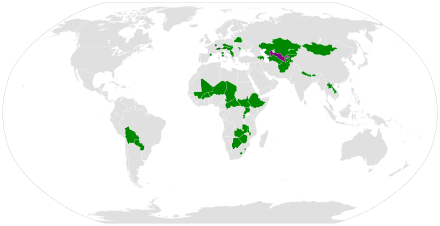
A landlocked country is a country that does not have any territory connected to an ocean or whose coastlines lie solely on endorheic basins. Currently, there are 44 landlocked countries, two of them doubly landlocked (Liechtenstein and Uzbekistan), and three landlocked de facto states in the world. Kazakhstan is the world's largest landlocked country, Kyrgyzstan is the furthest landlocked country from any ocean, while Ethiopia is the world's most populous landlocked country.[1][2]
Generally, being landlocked creates political and economic disadvantages that having access to international waters would avoid. For this reason, nations large and small throughout history have fought to gain access to open waters, even at great expense in wealth, bloodshed, and political capital.
The economic disadvantages of being landlocked can be alleviated or aggravated depending on degree of development, surrounding trade routes and freedom of trade, commonality of language, and other considerations. Some landlocked countries in Europe are affluent, such as Andorra, Austria, Liechtenstein, Luxembourg, San Marino, Switzerland, and Vatican City, all of which, excluding Luxembourg (a founding member of NATO), frequently employ neutrality in global political issues.
However, 32 out of the 45 landlocked countries, including those in Africa, Asia, and South America, have been classified as Landlocked Developing Countries (LLDCs) by the United Nations.[3] Nine of the twelve countries with the lowest Human Development Index rankings are landlocked.[4] International initiatives are aimed at reducing inequalities resulting from issues such as these, such as the United Nations Sustainable Development Goal 10, which aims to reduce inequality substantially by 2030.[5]
Cite error: There are <ref group=lower-alpha> tags or {{efn}} templates on this page, but the references will not show without a {{reflist|group=lower-alpha}} template or {{notelist}} template (see the help page).
- ^ "Largest LLC". United Nations Conference on Trade and Development.
- ^ "Landlocked country | Meaning, Examples, Maps, List, & Navies | Britannica". 5 August 2023.
- ^ Paudel, R. C. (2012). "Landlockedness and Economic Growth: New Evidence" (PDF). Growth and Export Performance of Developing Countries: Is Landlockedness Destiny?. Canberra, Australia: Australian National University. pp. 13–72.
- ^ Faye, M. L.; McArthur, J. W.; Sachs, J. D.; Snow, T. (2004). "The Challenges Facing Landlocked Developing Countries". Journal of Human Development. 5 (1): 31–68 [pp. 31–32]. doi:10.1080/14649880310001660201. S2CID 10442596.
- ^ "Goal 10 targets". UNDP. Archived from the original on 2020-11-27. Retrieved 2020-09-23.